 9/11 Memorial Competition Entry: Wiktor Szostalo, Poland/United States
9/11 Memorial Competition Entry: Wiktor Szostalo, Poland/United States
This following article was written by Lester Levine, author of the newly released book 9/11 Memorial Visions: Innovative Concepts from the 2003 World Trade Center Site Competition. Levine is a New York City-born poet and a management consultant now based in North Carolina. He says that curiosity led him to read through all 5,201 entries from the 2003 9/11 Memorial competition. In the book prospectus he writes, “I was a voyeur looking into shattered souls, a wide-eyed viewer into a hugely complex range of human creativity. I became enthralled.”
Levine also has several personal connections to the World Trade Center: He worked across the street from the site in the early 1990s, knew someone who was injured in the 1993 bombing, and his former boss was killed in on 9/11. His wife also knew a few people who lost their lives. Both him and his wife felt compelled to enter the 9/11 memorial competition themselves in 2003, which he says they did as “a cathartic experience. If we were inspired to enter, I wanted to understand other entrants’ reactions to this existential, world-altering event.”
This exploration turned into his newly released book, which tells the personal stories of those that submitted entries. He writes, “These stories uniquely illuminate how visceral reactions to powerful historic events get translated into creative expressions by both artistic and ordinary people, enabling broader and deeper thought about the relation of memorial structures and spaces to the history, geography, technology and cultural diversity of our 21st Century world.”
We are excited to share this article he has has written for us that looks at ten of the innovative ideas, arranged thematically, from the 9/11 Memorial competition that can be applied as inspiration for future memorials.
When I began the first-ever review of the 5,201 entries into the 2003 World Trade Center Memorial Design Competition, I had no idea what I might find. While most turned out to be variations of existing memorial constructs, a small portion genuinely challenged how public memory might be honored. It was the cusp of the new century with great change, especially in technology. I was intrigued by these divergent ideas and wanted to plumb their source.
And so my journey moved to the creators to learn the stories behind their ideas. These became a book, 9/11 Memorial Visions: Innovative Concepts from the 2003 World Trade Center Site Memorial Competition (McFarland & Company, 2016). This article provides a sampling.
Although the designs were specific to the 9/11 event, many of the core ideas could be used for future public memorials. Unfortunately, given our world, there will likely be more of them. Here are 10 thoughts for the future…you can learn more about each of these and many more in the book. Additional information is also available at the 9/11 Memorial Visions website and the accompanying Facebook page.
1. Memorials Without Borders
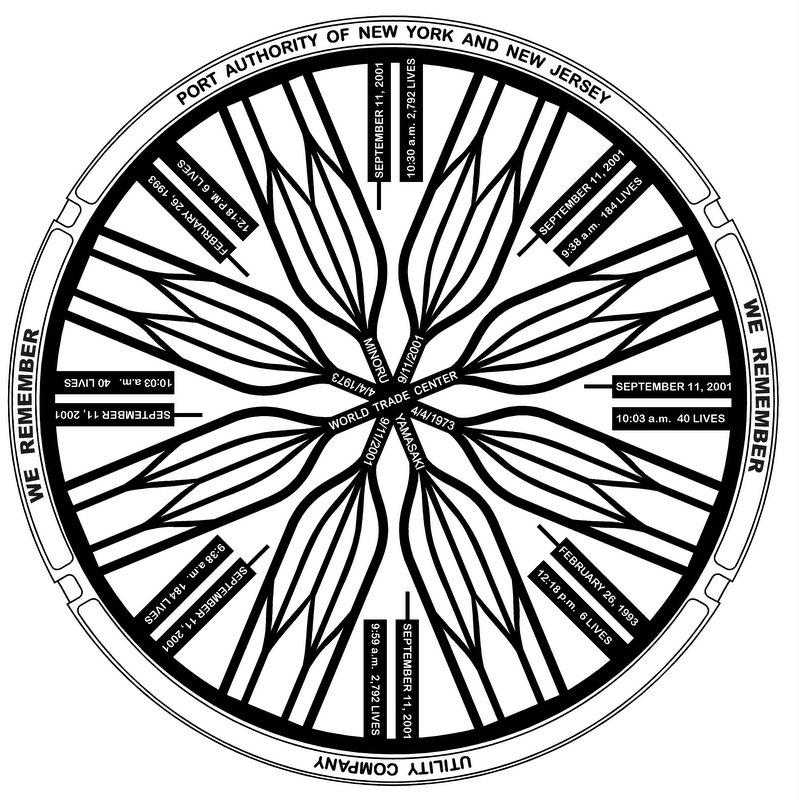 9/11 Memorial Competition Entry: Michelle Brody, New York City
9/11 Memorial Competition Entry: Michelle Brody, New York City
Most memorials are location specific. Some have been at multiple sites where victims lived, as the more than 50,000 sidewalk markers in Europe for those killed in the Holocaust, “stolpersteines” (literally “stumbling stones or blocks”). Many entrants wanted the 9/11 memorial to go beyond “Ground Zero” in New York City. Here are two examples of memorials that go beyond existing borders from an entire chapter of the book.
One expanded border memorial idea was from Michelle Brody of New York City. She proposed commemorative manhole covers across Lower Manhattan to remind people walking or driving as an “everyday” memory:
Michelle described the core design as a “mandala”, a kind of sacred space for meditation. She imagined a person at a cover “creating their own memorial” via a private experience in a public space.
Other entrants envisioned boundaries much further. Austrians Joel Cannive and Marc Kerger proposed a traveling memorial to allow people from the 82 countries represented by the victims to remember without necessarily going to New York City. They designed a kind of memorial crate that could be shipped by a cargo plane from country to country:
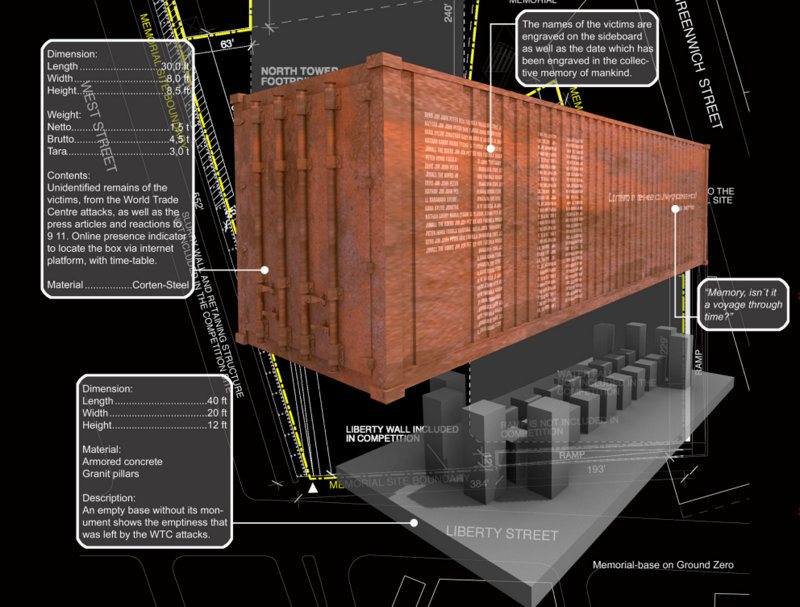 9/11 Memorial Competition Entry: Joel Cannive and Marc Kreger, Austria
9/11 Memorial Competition Entry: Joel Cannive and Marc Kreger, Austria
A quote on the entry frames the concept: “Memory, isn’t it a voyage through time?” They also implied that the interest would continually bring forth 9/11 memories at each stop by imagining headlines in local newspapers telling about the memorial and the local victims.
Memorials Using Sound
 9/11 Memorial Competition Entry: Wiktor Szostalo, Poland/United States
9/11 Memorial Competition Entry: Wiktor Szostalo, Poland/United States
The 21st Century is becoming ever more multi-sensory. Some Competition entrants proposed a number of ideas for “powering” memorials with sound. These are only two from a dedicated chapter of the book.
Wiktor Szostalo, a Polish sculptor who works in both Poland and the United States, combines two sound sources in his design – a lower one with pipes topped with another, using wind chimes.
He describes the visitor’s experience on the entry:
“As the wind swirls around, the Windpipes…give out a deep, vibrating mournful sound. As we follow the sound rising…the Symphony of Sorrow is met by a different sound, one…produced by…several thousand wind chimes… A much lighter sound, with overtones of hope.”
“The lighter sound…of the chimes will be symbolic of the victims’ continued existence, be that just in our memory, but also for many, as spirits looking over us bringing hope and peace.”
“Thus the music will become a continuous dialogue, a prayer, a meditation on death and the aftermath, on anger, mourning and hope, and our own place in All of This.”
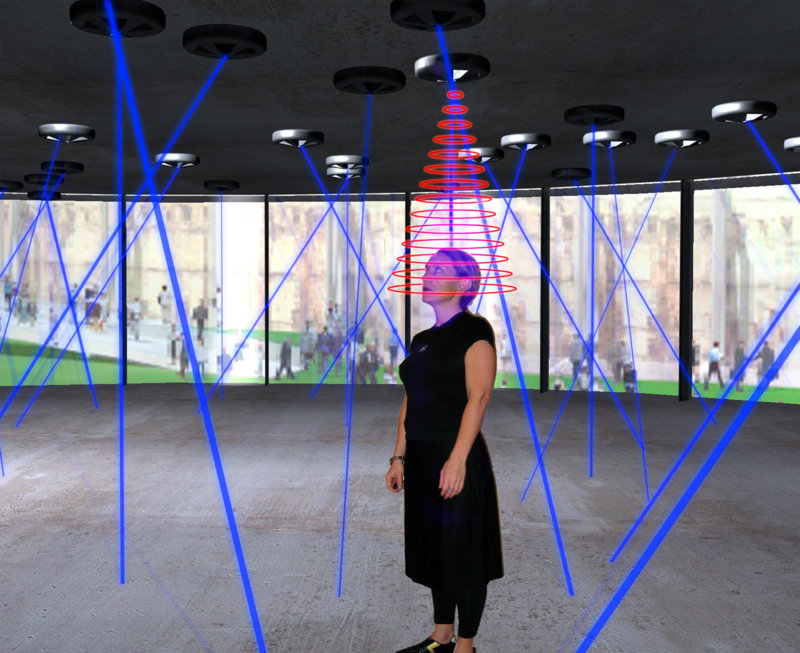 9/11 Memorial Competition Entry: Alison Cornyn, New York City
9/11 Memorial Competition Entry: Alison Cornyn, New York City
Alison Cornyn, a New York City interdisciplinary artist who works extensively with many technologies, imagined incorporating sound coming from visitors and delivering it via the then new “hypersonic” technology which directs sound to a small area without being heard around it. She pictured a visitor experiencing it:
It would be a “Chamber of Voices” where one can record and hear personal memorial reactions:
“… to the events of 9/11, the tragic loss of life, the courage of those who risked their lives, the compassion of those near and far, their hopes for the future…”
Light Driven Memorials
 9/11 Memorial Competition Entry: Garrett Finney, inventory
9/11 Memorial Competition Entry: Garrett Finney, inventory
We think of memorials we have seen and they are often stark greyscale, with little color other than foliage blossoms. A number of 2003 entrants thought that light and/or color should be the memorial focus – these are but two from the “light and color” chapter of the book.
Garret Finney, an inventor, envisioned using light from technology, a collimator, a “beam limiting device” sharply moving and focusing light. Walking around you would see the following:
“Each day the Collimator will collect the sun’s rays and use them to project the…names…into the shifting shaded portions of the site. [They] will move throughout the course of the day, tracking with the sun’s movement. The names will dance and float over the glass, brick, stone, concrete, trees, grass and people…The names will move in a seemingly random fashion but will follow a prescribed course just as the stars do…The names will be there and not there as they are projected into shadow and then get lost in the sunlight. The solitary traverse of each name will express each victim’s individual nature.”
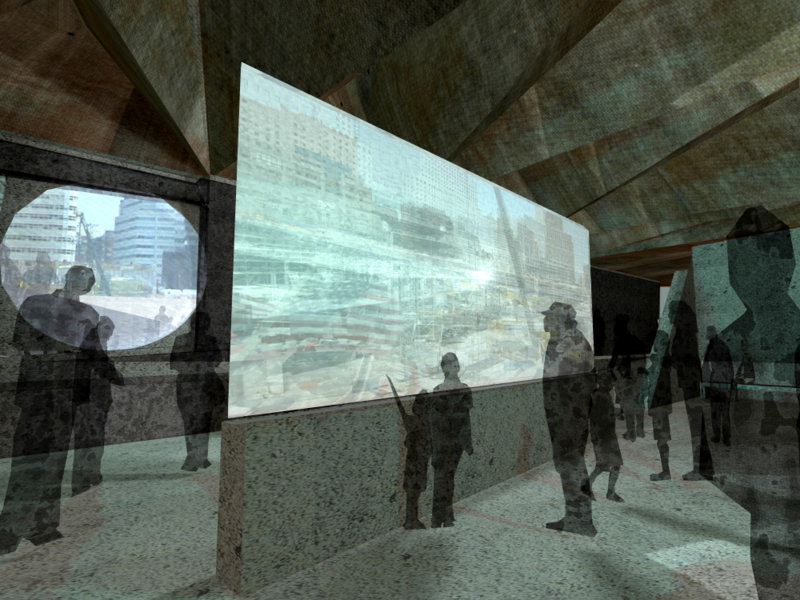 9/11 Memorial Competition Entry: David Schatzle, architect
9/11 Memorial Competition Entry: David Schatzle, architect
Architect David Schatzle had another approach using light. He powered his design by color, using camera obscura devices around the memorial to capture images of visitors. He believed memory needs to encompass both “the body and the soul” to “…affirm the reality of spirit and the reality of matter” and relate the one to the other.
There would be a central “fluid crystal” (liquid crystal) wall of light and color. From a distance, you would see a constantly changing blend of the images.
Up close you would see a mosaic of faces of the victims.
Memorials That Move
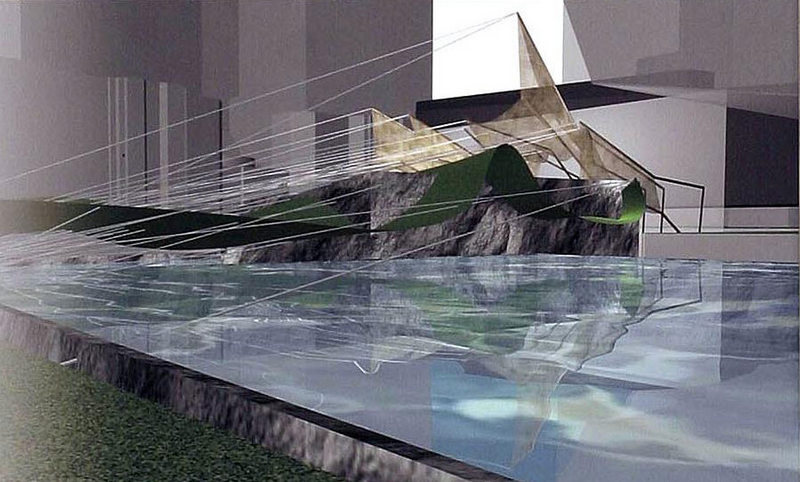 9/11 Memorial Competition Entry: Jonathan, Canada
9/11 Memorial Competition Entry: Jonathan, Canada
As most traditional memorials are greyscale, so are they static. Our new century has changed our perceptions to include the possibilities of what we experience being a “moving target.” Here is one example from the chapter about movement.
It was from a Jonathan in Canada. I never found him to hear his story, but his multi-dimensional moving memorial amazed me. Its purpose was to connect 9/11 to other tragic events in history, past, present and future.
“All…victims…are represented by an array of wires…connected to the bedrock of the site and at the other end to a series of steel columns. These wires will also attach to a grass ground plane floating at street level. The wires will express a degree of tension by deforming these columns into a wide variety of forms…and by pulling the ground plane into a variety of folds. Placed between each column are a series of fabric veils which will billow in the winds…and are a metaphoric expression of the souls of the victims. The columns will peel away from a large glass plane upon which are inscribed the place and dates of various atrocities that have occurred in the last century; the wires and veils will be symbolically using the deaths of the victims as a means of exposing other atrocities and will remember the countless unidentified victims of past events in our shared global community.”
Technology Memorials
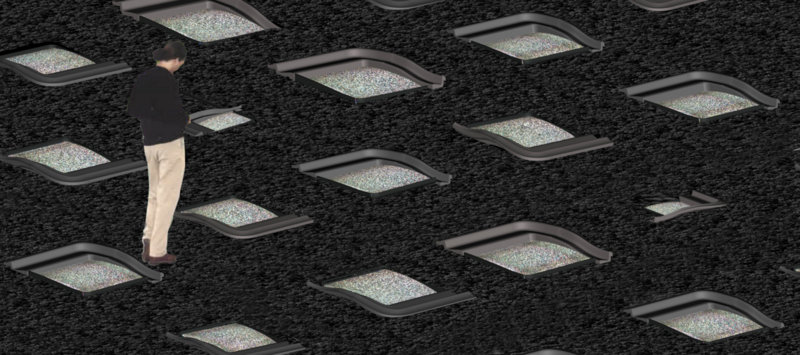 9/11 Memorial Competition Entry: John Zissovicki, architecture professor at Cornell University
9/11 Memorial Competition Entry: John Zissovicki, architecture professor at Cornell University
There were more technologies in 2003 besides hypersonic sound and collimators – think Internet and other digital tools. Why shouldn’t these, too, help us remember? There were a mass of ideas in the Competition about these. Here are two from a chapter on technology using video, not new, but becoming the source for instant news like the 9/11 attacks.
The first is from John Zissovicki, who teaches architecture at Cornell University and also develops design work using technology, especially video,
“Television was the medium through which millions of people all over the world watched the terrorist attacks…live and through endless subsequent replays.”
John envisioned a field of TV monitors, one for each victim:
“There are several different shapes and sizes of monitors. Chance will determine the particular monitor for each victim, as chance determined who lived or died.”
The first is from John Zissovicki, who teaches architecture at Cornell University and also develops design work using technology, especially video,
“Television was the medium through which millions of people all over the world watched the terrorist attacks…live and through endless subsequent replays.”
John envisioned a field of TV monitors, one for each victim:
“There are several different shapes and sizes of monitors. Chance will determine the particular monitor for each victim, as chance determined who lived or died.”
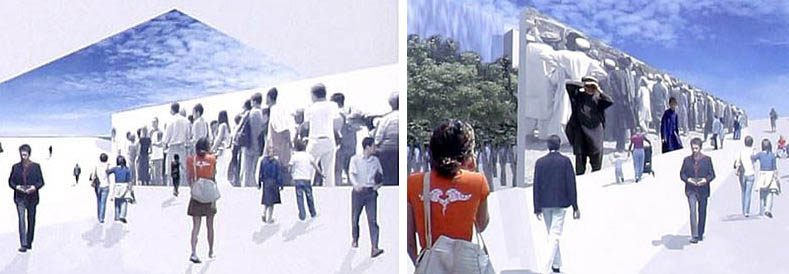 9/11 Memorial Competitino Entry: David, New York
9/11 Memorial Competitino Entry: David, New York
Another example came from David in New York. I never found him to learn more details beyond his entry.
The entry included two ingenious uses of video, which, in a way provide opposite reflections for the visitor. The first he calls “the wall of introspective reflection”:
“Video cameras are placed directly opposite of the wall that will capture images of the back of people walking passing along the wall. And then…the images will be broadcast on the wall. The wall is acting like a mirror except that it is the back of people that will be seen.”
David called the other “The Wall of Extrospective Empathy”. This required expanding the boundary of the memorial throughout the world:
“Video links will be established among similar memorial sites… at places …affected by the September 11 event and its aftermath… Video images of people from other sites will be broadcast on the wall and vice-versa…visual connections and interactions are established.”
The two video walls together are intended to provide a powerful memorial function: “The tensions between here and there make us ponder over our relationship with others.”
Memorial Visitor Engagement
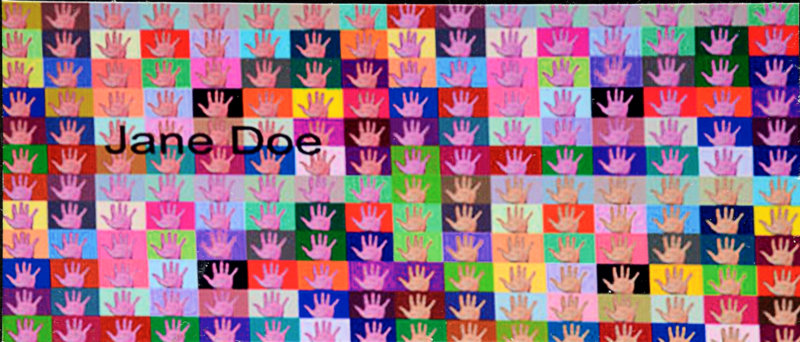 9/11 Memorial Competition Entry: John Crowley
9/11 Memorial Competition Entry: John Crowley
Another very fascinating set of designs involved asking visitors to “do something” at the memorial, very fitting in our new age of personalization, the “shopping experience” and the like – active, not passive memory. Here is an example from a chapter of many.
John Crowley works in designing exhibitions and public art. John’s entry is entitled “Hands Reaching Upward” and explained there:
“I visited Ground Zero and observed the letters, flowers and gifts that people had left to honor the fallen victims. The people were trying to reach out to the fallen…”
The design engages memorial visitors and is powered by digital technology:
“The viewer would walk up and place their hand on a [glass topped] podium, directly in front of [large] screens. A camera…will then take a snapshot of the person’s hand. The image will then be assigned a colored background and sent to the screens. The picture of their hand will then take its place with the other participants’ hands to create a giant mosaic…
The names of the victims of 9/11 will then appear at period intervals in large type scrolling across the screen.”
All of this before smartphones, virtual reality and whatever comes next. Static, greyscale uni-dimensional memorials imply death Future public memorials could be more; they could celebrate the victim’s lives and encourage the living to prevent their need.
Buy the book 9/11 Memorial Visions: Innovative Concepts from the 2003 World Trade Center Site Competition on Amazon.
Next, check out the Top 10 Secrets of the 9/11 Memorial, the version that was actually built. Also see the alternate plans for the World Trade Center that were never built.





